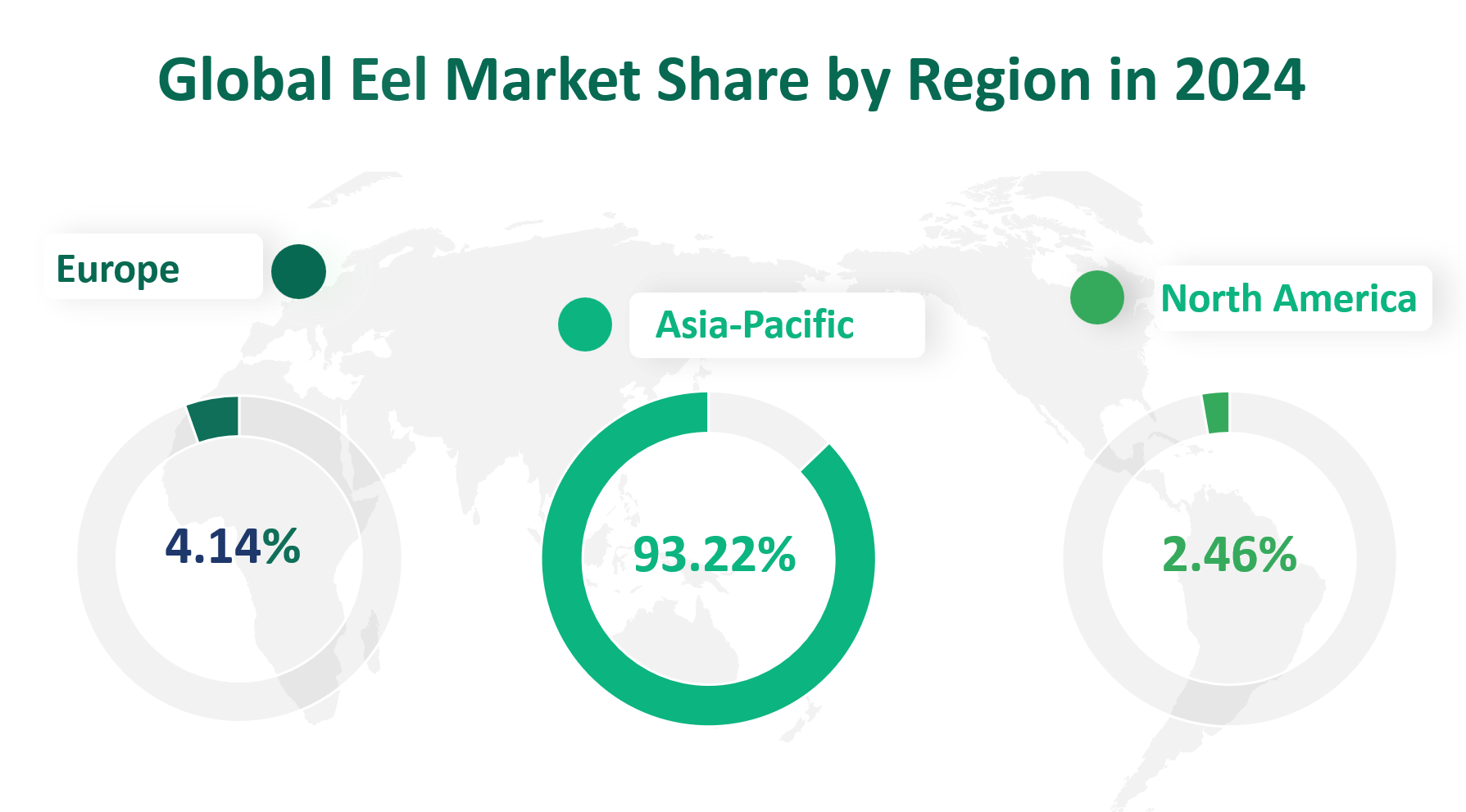1. Global Eel Market Insight Analysis
The global eel market value reached 7,840.99 million USD in 2024, with a Compound Annual Growth Rate (CAGR) of 2.73% from 2024 to 2033.
Eels, scientifically classified under the order Anguilliformes, are ray-finned fish characterized by their elongated, worm-like bodies. They are highly valued in many regions for their rich nutritional content and unique flavor. Freshwater eels, in particular, are a staple ingredient in Japanese cuisine, used in dishes such as eel rice and grilled eel. The majority of eel production globally is derived from aquaculture, which relies heavily on wild-caught juveniles due to the challenges in breeding eels in captivity. This dependency on wild fry not only impacts the supply chain but also raises concerns about sustainability and ecological balance.
Figure Global Eel Market Size (M USD) and CAGR (2024-2033)

2. Driving and Limiting Factors of Eel Market Growth
Japanese cuisine has gained immense popularity worldwide, particularly in Asia and Europe. Eel, as a classic ingredient in Japanese dishes such as eel rice (unagi don) and grilled eel (kabayaki), is highly sought after for its unique taste and nutritional value. The spread of Japanese culinary culture has directly boosted the demand for eel products. Additionally, eel is considered a luxury ingredient, especially in high-end restaurants, where its high price reflects its status and the complexity of production. As consumers’ living standards improve and their consumption concepts shift towards higher quality and more nutritious ingredients, eel has become a popular choice in the high-end ingredient market.
The growth of the downstream food processing industry has significantly contributed to the expansion of the eel market. Traditional eel consumption was primarily concentrated in specific places like Japanese restaurants. However, with the increasing demand and expanding sales channels, more consumers are now cooking eel dishes at home or purchasing ready-to-eat eel products. Food processing companies have introduced a wide variety of eel products, such as grilled eels, ready-to-eat eels, and eel snacks, which are convenient, nutritious, and appealing to a broader consumer base. Technological advancements in food processing have also improved the taste and safety of eel products, further driving market growth.
In many regions, eel consumption is deeply rooted in cultural and traditional practices. For example, in Japan, eel is a traditional delicacy often consumed during specific festivals and events. This cultural significance drives consistent demand for eel products, especially during peak seasons. Similarly, in other parts of the world, the popularity of eel dishes has been influenced by cultural exchanges and the globalization of food cultures.
Eel prices are generally high and subject to significant market volatility. The high cost of eel farming, particularly the reliance on wild-caught fry, contributes to the elevated prices. Fluctuations in the supply of eel fry due to natural factors such as climate change and overfishing can lead to price spikes. Additionally, the high-end food market’s demand for eel products further drives up prices, making eel less accessible to a broader consumer base. This volatility can deter some consumers and limit the overall market size.
Eel farming faces environmental challenges, including overfishing of wild eel fry and the potential impact on local ecosystems. To address these concerns, many countries have introduced fishing restrictions and protection policies to preserve eel populations. While these measures are essential for sustainability, they can limit the supply of eel fry available for aquaculture, increasing production costs and reducing the overall output. Regulatory constraints also add to the complexity and cost of eel farming, making it less attractive for new entrants.
One of the most significant challenges in eel farming is the inability to complete the entire life cycle in captivity. While some progress has been made in artificial breeding, it is still not commercially viable on a large scale. The reliance on wild-caught fry for breeding means that eel farming is highly dependent on natural resources, which are subject to environmental and climatic factors. This dependency makes the industry vulnerable to supply chain disruptions and increases operational risks.
3. Technology Innovation in Eel Market
One of the most notable technological innovations is the adoption of Recirculating Aquaculture Systems (RAS). These systems allow for the efficient and sustainable farming of eels by recycling water and minimizing waste. RAS technology not only reduces the environmental impact of eel farming but also enhances the quality and consistency of eel production. Companies like Yamada Suisan Co., Ltd. and Taishan Lvsheng Food Co., Ltd. have implemented RAS to improve their breeding efficiency and reduce reliance on wild-caught fry.
Advancements in artificial breeding techniques have been a game-changer for the eel industry. While full-cycle artificial breeding remains a challenge, significant progress has been made. For example, Kinki University in Japan successfully achieved full-cycle farming of Japanese eels in an experimental setting. This breakthrough could potentially revolutionize the industry by providing a stable supply of eels independent of wild-caught fry. Companies are investing heavily in research and development to commercialize these techniques.
In the food processing sector, innovations such as vacuum frying, deodorization methods, and pre-drying processes have improved the taste and safety of eel products. These advancements have enabled the production of a wider variety of eel products, including ready-to-eat snacks and processed eels, which appeal to a broader consumer base. Companies like ZEHUI AOUACULTURE (GUANG ZE) CO.LTD and Delaware Valley Fish Company are at the forefront of these innovations, offering a diverse range of products that cater to different consumer preferences.
4. Global Eel Market Size by Type
The eel market can be segmented into two primary product types: Wild Eel and Artificial Raising Eel.
Wild eels are primarily freshwater eels, known for their rich flavor and high fat content, making them highly sought after for culinary purposes. They are typically caught in the wild and are considered a delicacy in many regions, particularly in Japanese cuisine. In 2024, the market value of wild eels reached approximately 344.77 million USD.
Artificial raising eels, on the other hand, are cultivated in controlled environments. These eels are bred from wild fry and raised in farms, which allows for a more consistent supply compared to wild-caught eels. In 2024, the market value of artificial raising eels was approximately 7496.22 million USD, accounting for 95.60% of the total eel market value.
Table Global Eel Market Size by Type in 2024
Market Size (M USD) 2024 | Market Share | |
Wild Eel | 344.77 | 4.40% |
Artificial Raising Eel | 7496.22 | 95.60% |
5. Global Eel Market Size by Application
The eel market can be further segmented based on its applications, which include Retail, Food Process, and Food Services.
The retail segment of the eel market involves the sale of eel products directly to consumers through various channels, including supermarkets, seafood markets, and online platforms. In 2024, the market value of eel products in the retail segment reached approximately 2633.11 million USD, accounting for 33.58% of the total eel market value.
The food processing segment involves the transformation of eel products into various forms, such as grilled eels, smoked eels, and ready-to-eat eel products. In 2024, the market value of the food processing segment was approximately 3024.65 million USD, representing 38.57% of the total eel market value.
The food services segment includes catering institutions and restaurants that serve eel dishes to consumers. In 2024, the market value of the food services segment was approximately 2183.23 million USD, accounting for 27.84% of the total eel market value.
Table Global Eel Market Size by Application in 2024
Application | Market Size (M USD) 2024 | Market Share |
Food and Beverages | 1451.24 | 75.34% |
Animal Feed | 52.76 | 2.74% |
Dietary Supplement | 305.61 | 15.87% |
Others | 116.57 | 6.05% |
6. Global Eel Market by Top Regions
The Asia Pacific region is the largest market for eels, with a market value of 7309.67 million USD in 2024. This region accounts for 93.22% of the total global eel market value. The dominance of the Asia Pacific region is primarily due to the high demand for eel products in countries like China, Japan, and South Korea. These countries have a strong cultural affinity for eel dishes, particularly in Japanese cuisine, where eel is a staple ingredient.
Europe is the second-largest market for eels, with a market value of 324.28 million USD in 2024, representing 4.14% of the global market value. European countries, particularly those in the Mediterranean and Northern Europe, have a significant demand for eel products. The region is known for its high-quality eel processing and distribution infrastructure, which supports both domestic consumption and exports.
North America’s eel market value in 2024 was 192.90 million USD, accounting for 2.46% of the global market value. The United States and Canada are the primary markets in this region, with a growing demand for eel products driven by the increasing popularity of Japanese cuisine and other high-end culinary experiences.
The Middle East and Africa region had a market value of 5.83 million USD in 2024, representing 0.11% of the global eel market value.
South America’s eel market value in 2024 was 8.31 million USD, accounting for 0.11% of the global market value.
Figure Global Eel Market Size by Region in 2024

7. Global Eel Market Analysis by Major Players
7.1 ZEHUI AOUACULTURE (GUANG ZE) CO.LTD
Company Introduction and Business Overview: Founded in 2017, ZEHUI AOUACULTURE (GUANG ZE) CO.LTD is a modern aquaculture company based in China. The company uses advanced Danish circulating water process technology and focuses on breeding high-end freshwater fish, including Japanese eels and American eels. ZEHUI AOUACULTURE is known for its commitment to sustainable and high-quality aquaculture practices.
Products Offered: ZEHUI AOUACULTURE offers a range of eel products, including live, fresh, and processed eels. Their products are marketed both domestically and internationally, with a strong presence in the European and Asian markets.
Sales Revenue in 2024: In 2024, ZEHUI AOUACULTURE (GUANG ZE) CO.LTD achieved a sales revenue of 306.71 million USD.
7.2 Yamada Suisan Co., Ltd.
Company Introduction and Business Overview: Established in 1963, Yamada Suisan Co., Ltd. is a renowned eel producer based in Japan. The company specializes in eel farming and processing, with a focus on delivering high-quality eel products. Yamada Suisan is known for its strict quality control and sustainable farming practices.
Products Offered: Yamada Suisan offers a variety of eel products, including fresh, frozen, and processed eels. Their products are popular in the Japanese market and are also exported to other countries in the Asia Pacific region.
Sales Revenue in 2024: In 2024, Yamada Suisan Co., Ltd. achieved a sales revenue of 72.91 million USD.
7.3 YONKYU
Company Introduction and Business Overview: Founded in 1963, YONKYU is a leading eel producer based in Japan. The company specializes in eel farming and processing, with a focus on delivering high-quality eel products. YONKYU is known for its advanced farming techniques and commitment to sustainable practices.
Products Offered: YONKYU offers a range of eel products, including fresh, frozen, and processed eels. Their products are popular in the Japanese market and are also exported to other countries in the Asia Pacific region.
Sales Revenue in 2024: In 2024, YONKYU achieved a sales revenue of 70.00 million USD.

